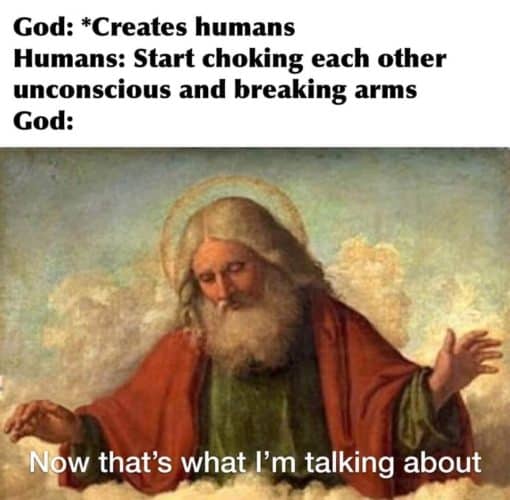God Creates humans Humans Start choking each other
The image shows a depiction of a figure that is traditionally identified as God, characterized with long flowing white hair and beard, draped in a red and green robe. This figure's arms are spread in a wide, embracing gesture, and the face is turned slightly away from the viewer with the eyes looking down in a contemplative or perhaps even pleased manner.
Above the figure, there is text that reads as a dialogue with two speakers. The first speaker is "God," whose action is described as '*Creates humans.' The sentence sets up an expectation of some sort of divine or important observation regarding humanity. The second line references "Humans," and provides an action contrasting sharply with the initial serene scene suggested by the creation of humans, stating 'Start choking each other unconscious and breaking arms,' which suggests violent human behavior.
Below the figure of God, the response from the divine perspective is delivered with a popular colloquial phrase, 'Now that's what I'm talking about,' which is typically used to express approval or excitement about something that is happening or has been said. The phrase is depicted in bold white letters to stand out from the background, capturing the viewer's attention.
The humor in this image arises from the juxtaposition of the divine act of creation with the seemingly un-divine and violent human behavior. It plays on the expected dissonance between God's presumably benevolent intentions in creating humans and the imperfect, often chaotic reality of human actions. This disconnect between expectation and reality is a common source of humor.
The chosen colloquial phrase 'Now that's what I'm talking about' normally implies joyful approval or enthusiasm, which is humorously applied to a situation that would realistically elicit the opposite reaction, especially from a divine being who just created humanity. By portraying the divine figure as having a cavalier or even a supportive reaction to human violence, the image satirizes human behavior and perhaps also critiques idealized expectations of divine oversight or intentions.
Lastly, the image might be considered funny because it uses a traditional, solemn style of religious artwork to deliver a modern and irreverent punchline. The mixing of sacred with the playful banter of internet meme culture creates a striking contrast that can evoke laughter due to its unexpectedness and the subversion of the original context of the artwork. God Creates humans Humans Start choking each other unconscious and breaking arms God Now that s what I m talking about
